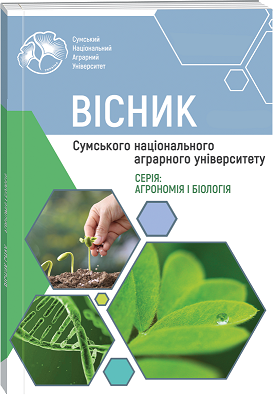CLONING AND BIOINFORMATICS ANALYSIS OF WHEAT POWDERY MILDEW RESISTANCE RELATED GENE TAGDSL
Abstract
Powdery mildew disease of wheat is caused by Blumeri agraminis F. sp. tritici. It is one of the primary fungal diseases of wheat. Therefore, it is of great significance to explore and utilize the broad spectrum anti-powdery mildew genes and study their resistance mechanism and molecular mechanism for effectively resisting the harm of powdery mildew. Material is wheat variety Bainong207 supplied by Henan Provincial Research Center of Food Crop Genome Editing Engineering Technology. PmD-19T vector, E. coli 5α, and Agrobacterium GV3101 strain were purchased from Takara Biological Company. PCR apparatus, electrophoresis apparatus, agarose gel electrophoresis imager, autoclaving cooker, water bath cooker, ultra-clean workbench, etc. RT-PCR cloned the entire length of the TaGDSL gene. Bioinformatics analysis of the sequence showed that the total length of ORF was 1269bp, encoding 423 amino acids, with a molecular weight of 38.99 kD and an isoelectric point of 8.19. In addition, the TAGDSL gene has a transmembrane domain, a signal peptide, and the protein is hydrophilic. GDSL lipase is involved in plant physiological metabolism and local and global immunity. It is of great significance for improving disease resistance and yield of wheat. Based on the previous research, this experiment cloned the full-length sequence of a wheat GDSL gene, which enriched the members of the plant GDSL lipase family. She provided a basis for the subsequent exploration of its function and mechanism of action in the resistance to powdery mildew by modern molecular biology methods and the study of its gene function. The TAGDSL lipase gene of wheat was closely related to the durum wheat gene and barley gene by phylogenetic tree analysis. At the same time use bioinformatics method to forecast the gene can be more intuitive and more comprehensive understanding of its structure and properties, for the subsequent use of modern molecular biology methods to explore its function and role in the resistance to powdery mildew mechanism to provide effective basis, and for creating varieties of wheat powdery mildew resistance gene source and theoretical basis.
References
2. Beisson, F., Gardiesa, A. M., Teissere, M., Ferté, N., & Noat, G.(1997). An esterase neosynthesized in postgerminated sunflower seeds is related to a new family of lipolytic enzymes. Plant Physiology and Biochemistry, 35(10), 761–775.
3. Hao, X. Y, Yuan, H. L., Li, H. B., & Cai, Y. (2014). Overexpression of a cotton GDSL lipase increases the oil content of Brassica napus L. Journal of the Chinese Cereals and Oils Association, 29(6), 63–68.
4. Han, S., & Xiang, B. C. (2006). Advances of methods for the molecular detection of plant virus. Journal of Shihezi University (Natural Science), 24(5), 550–553.
5. He, Z. H., Zhuang, Q. S., & Cheng, S. H. (2018). Development of wheat industry and scientific and technological progress in China. Journal of Agriculture, 1, 107–114.
6. Huang, L. M., Lai, C. P., Chen, L. F., Chan, M. T., & Jei-Fu,Shaw, J. F. (2015). Arabidopsis SFAR4 is a novel GDSLtype esterase involved in fatty acid degradation and glucose tolerance Botanical Studies, 56(1), 1–12.
7. Edwards, H. H. (2002). Development of primary germ tubes by conidia of Blumeria gramini sf. sp. hordei on leaf epidermal cells of Hordeum vulgare. Canadian Journal of Botany, 80(80), 1121–1125.
8.Graham, P Feeney, Dongling, Zheng, & Hogstrand, P. K. C. (2005). The phylogeny of teleost ZIP and ZNT zinc transporters and their tissue specific expression and response to zinc in zebrafish. Biochemica et Biophysica Acta,1–3, 88–95.
9. Griffey C., Das M. & Stromberg E. (1993). Effectiveness of adult-plant resistance in reducing grain yield loss to powdery mildew in winter wheat. Plant Disease, 77(6), 618.
10. Jeum Kyu Hong, Hyong Woo, Choi,In Sun, Hwang,Dae Sung, Kim,Nak Hyun, Kim,Du Seok, Choi,Young Jin Kim, Byung Kook Hwang (2008). Function of a novel GDSL- type pepper lipase gene GLIP1 in disease susceptibility and abiotic stress tolerance. Planta, 227(3), 539–558.
11. Johnson J. W., Yamazaki W. T., & Smith T. R. (1979). Effects of powdery mildew on grain yield and quality of isogenic lines in “Chancellor” Wheat. Crop Sci., 19, 349–352.
12. Kram, B. W., Bainbridge, E. A, Perera, M. A. & Carter, C. (2008). Identification, cloning and characterization of a GDSL lipase secreted into the nectar of Jacaranda mimosa folia. Plant Mol. Biol., 68, 173–183.
13. Kuraparthy, V., Chhuneja, P., Dhaliwal, H., Kaur, S., Bowden, R. L., & Gill, B. S. (2007). Characterization and mapping of cryptic alien introgression from Aegilops geniculata with new leaf rust and stripe rust resistance genes Lr57 and Yr40 in wheat. Theoretical and Applied Genetics, 114(8), 1379.
14. Kondou, Y., Nakazawa, M., Kawashima, M., Ichikawa, T., Yoshizumi, T., Suzuki, K., Ishikawa, A., Koshi, T., Matsui, R., Muto, S. (2008). Retarded growth of embryo1, a new basic helix-loop helix protein that hosts an endosperm to control embro growth. Journal of China Physiology, 147, 1924–1935.
15. Lee, K. & Cho, T. (2003). Characterization of a salicylic acid-and pathogen induced lipase like gene in Chinese cabbage. Journal of Biochemistry and Molecular Biology, 36(5), 433–441.
16. Lee, D. S., Kim, B. K., & Kwon, S. J. (2009). Arabidopsis GDSL lipase 2 plays a role in pathogen defense via negative regulation of auxin signaling. Biochemical and Biophysical Research Communications, 379(4), 1038–1042.
17. Ling, H. (2007). Cloning and prokaryotic expression of GDSL1 gene in Brassica napus. Journal of Agricultural Biotechnology, 123(12), 102–106.
18. Ling, H. (2008). Sequence analysis of GDSL lipase gene family in Arabidopsis thaliana. Pakistan Journal of Biological Sciences, 11(5), 763–767.
19. Liu, W. C., Liu, Z. D., Huang, C, Lu, M. H., Liu, J. & Yang, Qi. P. (2016). Statistic and analysis of crop diseases and insect pests in recent 10 years. Plant Protection, 42, 1–9.
20. Machinaka, M., Nobutaka, M., & Nobutaka, M. (2010). Causes cucuglossus and particular defects. Plant and Cell Physiology, 51(1), 123–131.
21. Morgulis, A., Gertz, E. M., Schäffer, A. A.& Agarwala, R. (2006). Bioinformatics, 2, 134–141.
22. Naranjo, M. A., Forment, J., Roldán, M., Serrano, R., & Vicente, O (2006). Overexpression of Arabidopsis thaliana LTL1, a salt-induced gene encoding a GDSL-motif lipase, increases salt tolerance in yeast and transgenic plants. Plant Cell & Environment, 29(10), 1890–1900.
23. Oh, I. S. & Sun, J. K. (2005). Secretome analysis reveals an arabidopsis lipase involved in defense against Alternaria brassicicola. The Plant Cell, 17, 2832–2847.
24. Pruitt, K. D., Brown, G. R., & Hiatt, S. M. (2014). Nucleic Acids Research, 42, 756–763.
25. Qiu, L. N. (2019). Genetic analysis and molecular mapping of mildew resistance gene ML3IW125 in wheat. Crop Society of China Summary collection of the 10th National Congress on Wheat Genomics and Molecular Breeding. Crop Society of China, 229.
26. Shao, J. L., Niu, W. G., Liu, H. Y., Ni, M., Qiao, Z. C. & Shang, Y. Q. (2009). Analysis on pathogenicity differentiation of cotton Verticillium dahliae trains and its genetic diversity in Xinjiang. Xinjiang Agricultural Sciences, 46(1), 122–127.
27. Shen, Y. J., Zhu, X. Y., Dai, Q. & Xie, K. B. (2019). Experimental research on “fungal diseases of wheat” based on POE teaching strategy. Biology Teaching, 44(09), 59–61.
28. Sugui, J. A., Pardo, J., Chang, Yun C., Müllbacher, A., Zarember, Kol. A., Galvez, Eva M., Brinster, L., Zerfas, P., Gallin, J. I., Simon, M. M., Kwon-Chung, K. J. (2007). Role of laeA in the regulation of alb1, glip, conidial morphology and virulence in Aspergillus fumigatus. Eukaryotic Cell, 6(9), 1552–1561.
29. Tian, X. M., & Xu, L. F. (1991). The relations between resistance of cotton to Verticillium and Fusarium wilt and peroxidase activity. Acta Phytopathologica Sinia, 21(2), 94.
30. Wang, Z., Li, J., Chen, S., Heng, Y., Chen, Z., Yang, J., Zhou, K., Pei, J W, He H, Deng, X. W., & Ma, L. G. (2017). Poaceae-specific MS1 encodes a phospholipid-binding protein for male fertility in bread wheat. Proceedings of the National Academy of Sciences of the United States of America, 114, 12614–12619.
31. Wang, H., Liu, H., Yuan, H. X., Wang, Y., Li, H. L. (2001). The Change of enzymes activity and phenois content in cotton cultivars with different resistance to V. dahliae after inoculation. Acta Agriculture Boreali-Sinica, 16(3), 46–51.
32. Yu, Y. & Zhang, H. (2013). The occurrence and control of powdery mildew in wheat. Henan Science and Technology, 8, 187.
33.Yuan H. L., Hao X. Y., Zheng X. W., & Li, H. B. (2015). Cotton GDSL lipase increases the resistance against Verticillium dahliae. Journal of Shihezi University (Natural Science), 33(5), 529–534.
34. Zeng, F. S. (2017). Cloning and functional analysis of a nontoxic gene AVRPM2 and sporulation related gene STPK2 from Wheat powdery millet. Wuhan University.
35. Zhang, Z., Henderson, C., Perect, E., Carver, T. L. W. ,Thomas, B J ,Skamnioti, P ,Gurr, S. J. (2005). Of genes and genomes, needles and haystacks Blumeria graminis, and functionality. Molecular Plant Pathology, 6(5), 561–575.
36. Zou, B., Ding, Y., Liu, H., & Hua, J. (2017). Silencing of copine genes confers common wheat enhanced resistance to powdery mildew. Molecular Plant Pathology, 9, 1343–1352.
37. Zuo, K, Jin, W., Wu, W., Chai, Y., Sun, X., & Tang, K (2005). Identification and characterization of differentially expressed ESTs of Gossypium barbadense infected by Verticillium dahliae with suppression subtractive hybridization. Mol. Biol. (Mosk), 39(2), 214–223.

 ISSN
ISSN  ISSN
ISSN 


